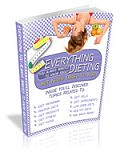Welcome to Diet Guide
Blood Type Diet Article
 To bookmark this article for further reading, click here.
To bookmark this article for further reading, click here.
Diet Program – Review Of The Cheater’s Diet
The Cheater’s Diet is a diet program designed to help individuals indulge in their favorite foods.
The idea behind this diet is that when people diet they tend to cheat by eating foods not on the plan. However, with this diet there is a time of eating whatever foods the individual wants built right in.
On Monday thru Friday individuals are expected to eat healthy, well portioned meals, but on Saturday and Sunday individuals can eat whatever foods they choose with no restrictions.
The diet program also recommends some supplements, however the supplements are not needed to lose weight with this diet.
With this diet program during the week, individuals eat plenty of fruits, vegetables, whole grains, lean protein, low fat dairy, peanuts, and unsaturated fats.
Individuals are also encouraged to get as much exercise in as they can. They can enjoy three meals and two snacks during the week. To balance the meals, they should have one half plate full of fruits or vegetables, one quarter lean protein, and one quarter whole grain.
Individuals are taught how to visually determine a portion size, for example a serving of protein is about the size of a deck of cards.
During the weekend, this diet program provides an opportunity to eat any food the individual wants between nine o’clock in the morning on Saturday and nine o’clock in the evening on Sunday.
Individuals can eat pizza, wine, ice cream, chocolate, peanut butter, cinnamon buns, strawberry shortcake, cheese, bread, meat, nuts etc. The only caution that is provided is that individuals should avoid foods that trigger binge eating.
The theory behind this diet program is that under eating tends to drop an individuals metabolism. By overeating on the weekend, an individual can boost their metabolism enough to have it continue through out the entire week. This will keep that individual from yo-yo dieting between the week days and the weekend.
Sample Weekday Menu
* BreakfastTwo eggs, any style (cook with PAM cooking spray)
One medium orange or one half grapefruit
Coffee or tea with artificial sweetener and nonfat milk
* Lunch
Four ounces tuna packed in water on a whole grain pita or tortilla. Mix with
olive oil or fat-free mayo, or mustard, or lemon with salt and pepper
Tomato and lettuce
A serving of any vegetable
Diet iced tea or water with lemon and artificial sweetener
* Snack
One handful of peanuts (fresh, dry-roasted, no salt or oil added)
* Dinner
Grilled sliced chicken breast strips
Steamed broccoli and peppers
Wild rice
*Snack
One cup hot cocoa, sweetened with artificial sweetener



